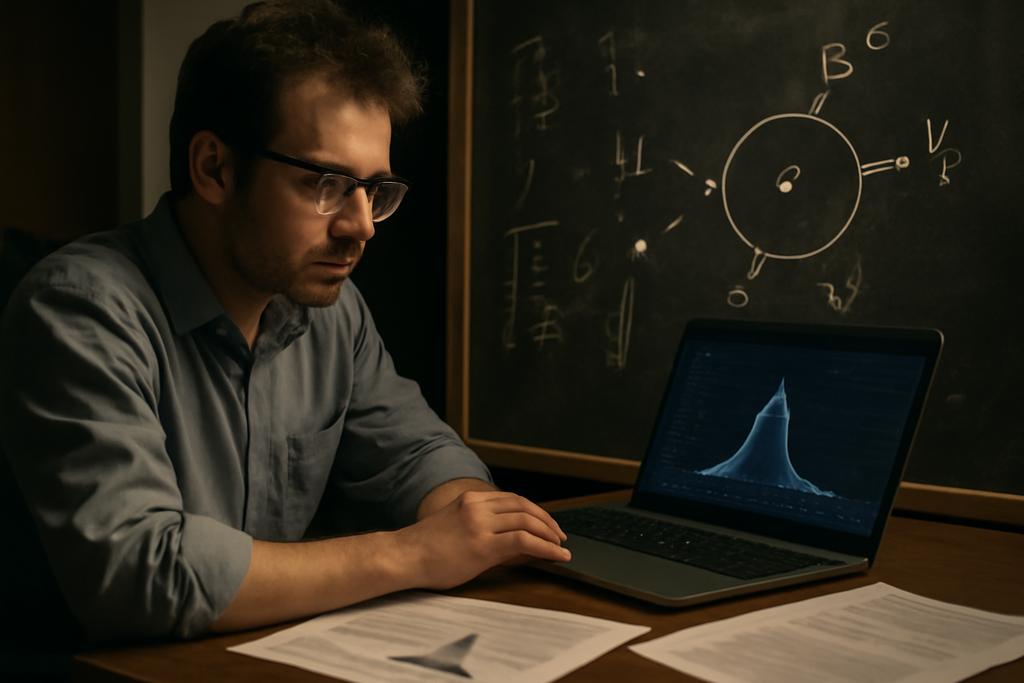A Subatomic Puzzle
Imagine a universe governed by invisible forces, where particles dance to the rhythm of fundamental interactions. This is the realm of particle physics, where scientists unravel the mysteries of matter’s deepest structure. A recent study from researchers at Nanchang Normal University, Henan University of Science and Technology, and Jiangxi Normal University delves into one of these mysteries: the intricacies of charmless semileptonic B meson decays. This seemingly esoteric topic holds profound implications for our understanding of the universe’s fundamental building blocks and the forces that govern them. The lead researcher on the study was Ru-Min Wang.
The B Meson’s Mysterious Transformation
At the heart of this research lies the B meson, a subatomic particle composed of a bottom quark (b) and a lighter quark (u, d, or s). Semileptonic decays are a particular type of transformation where the B meson changes into a lighter meson (P or V), along with a lepton (ℓ) and a neutrino (ν). The ‘charmless’ aspect means there is no charmed quark involved in this transformation, making the decay simpler in some theoretical models, even as they’re complicated to study.
These decays are like intricate dances where the bottom quark transforms into a lighter up quark, emitting a W boson which decays into a lepton and a neutrino. The resulting final states are complex, involving various resonant and non-resonant contributions. These contribute to the decay’s overall probability (the branching ratio).
Flavor Symmetry and the Strong Force
The complexity arises from the strong force, a powerful fundamental interaction that dictates how quarks interact with each other within the mesons. This force is governed by quantum chromodynamics (QCD), a theory that’s challenging to calculate accurately for mesons containing multiple quarks. To overcome this, researchers leverage a powerful technique called SU(3) flavor symmetry. This symmetry approach makes certain assumptions about the relationships between the behavior of different types of quarks (up, down, and strange). The assumption is that, to some degree of accuracy, the strong interaction doesn’t “care” if the particle is one type of quark or another. This simplifies the calculations significantly while giving a reasonable approximation to the system’s actual behavior.
Think of it like this: imagine you’re choreographing a dance with three different types of dancers. You could simplify the process by assuming that all three types of dancers have essentially the same movement capabilities, even if, in reality, there are subtle differences in their styles. This simplification allows you to focus on the overall dance structure without getting bogged down in the specifics of each dancer’s technique. Similarly, SU(3) flavor symmetry helps researchers simplify the complex interactions between quarks inside mesons.
Predicting the Unseen
The researchers applied the SU(3) flavor symmetry analysis to predict the branching ratios for various charmless semileptonic B meson decays. Many of these decays have yet to be observed experimentally, underscoring the predictive power of this theoretical approach. By employing relations established by the symmetry, researchers can extrapolate from experimentally observed decays to those that have not yet been seen. The predicted branching ratios give experimentalists targets to aim for — these predictions become testable hypotheses that can either validate or refine our theoretical understanding of these decays.
Resonances: The B Meson’s Inner Life
The study further explores the role of intermediate resonance states—particles that briefly appear and disappear during the decay process. These resonances, which include axial-vector, tensor, and excited vector mesons, act as stepping stones in the B meson’s transformation. These mesons act as fleeting intermediaries in the decay chain, each with its own properties influencing the final outcome.
The authors of the study carefully analyzed the contributions from these resonances. Their analysis is detailed and includes the important effects of the width of these resonance states, which are often not negligible. This adds another layer of complexity and affects the predicted branching ratios. While the narrow width approximation simplifies the calculations, the analysis also includes a more sophisticated approach to take these effects into account. It’s a subtle but important improvement that demonstrates the precision of the theoretical modeling involved.
The Future of B Meson Physics
This research holds significant value for advancing our understanding of the fundamental interactions governing matter at its most basic level. The results offer valuable insight into meson spectroscopy — the study of mesons and their properties, which are essential for verifying and refining theoretical models of QCD. The predictions made in this study will be tested by ongoing experiments at facilities such as Belle II and LHCb. These experiments are capable of producing and studying a sufficient number of B meson decays to validate (or refute) these predictions. Future data from these experiments will refine our understanding of these intricate processes and help us better grasp the fundamental laws of the universe.
The research illustrates a beautiful synergy between theory and experiment. The theoretical predictions guide experimental efforts, while experimental results feed back to refine and extend the theoretical framework. This iterative approach pushes the boundaries of our knowledge about subatomic phenomena, helping us to solve some of the most profound mysteries of particle physics. The study is a testament to this interdisciplinary collaboration and the ongoing efforts to unravel the deepest secrets of the universe.










